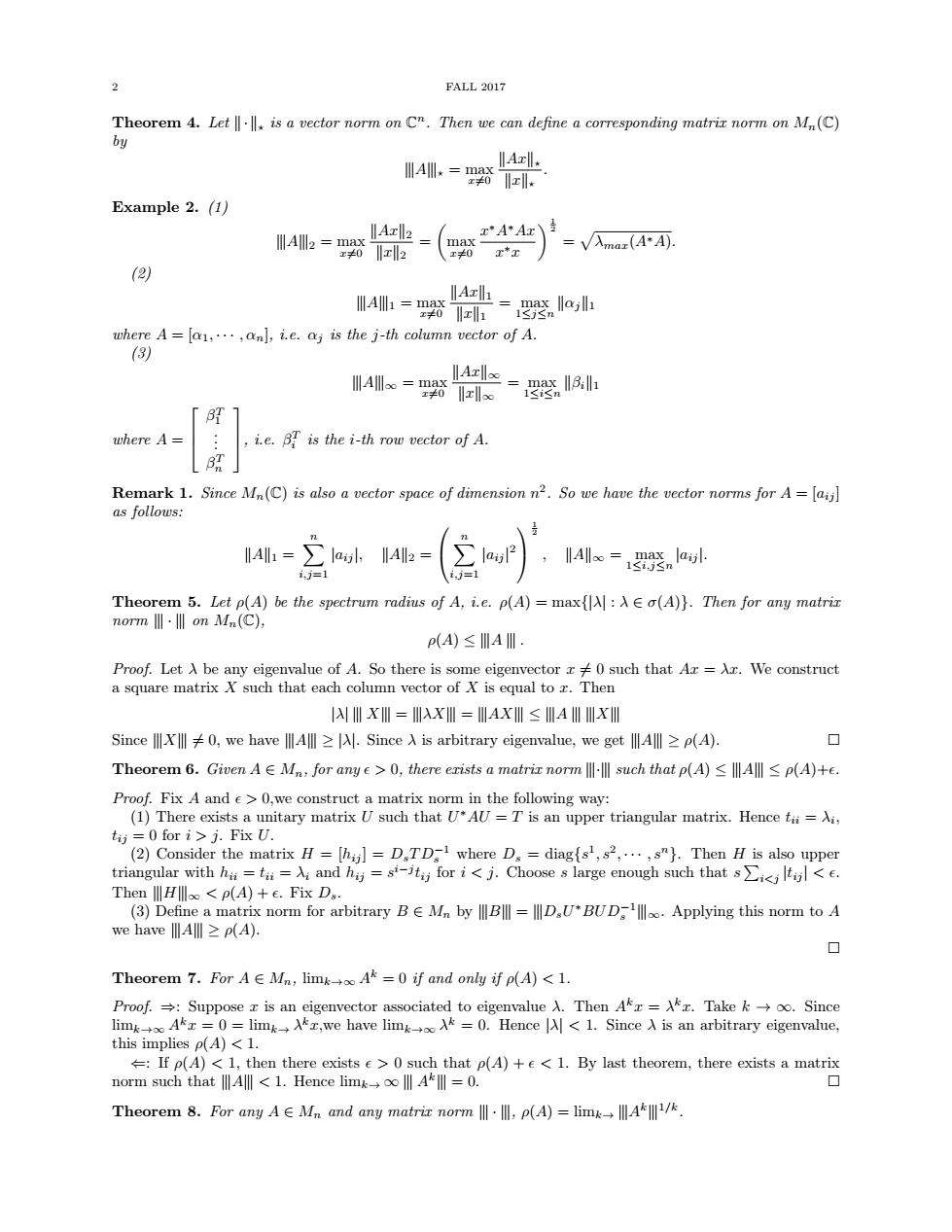正在加载图片...

2 FALL 2017 A:=罗件 Example 2.(1) 4=警件-(学空)广=网 (② 4=器快=器 小=a…,the c eor九 =器 A<=野 where A= i.e.B is the i-th row vector of A. Remark 1.Since Mn(C)is also a vector space of dimension n2.So we have the vector norms for A=[aijl as follows: 41=∑ll,A2=∑alP,Ae=竖nal 1.0m1 p(A)≤ⅢAⅢ. ARe4tXfh红-aeon时 I入ⅢXI=川入X=ⅢAX≤川AX Since≠0,we havelAll≥lM.Since入is arbitrary eigenvalue,.we getAll≥p(A). Theorem 6.Given AE M,for anye>,there erists a matriz norm such that p(A)All p(A)+e. Proof.Fix A and e>0,we construct a matrix norm in the following way: (1)There exists a unitary matrix U such that UAU=T is an upper triangular matrix.Hencet=Ai, Thenl(A)+e.Fix D.. (3)Define a matr x norm for arbitrary BE Mn byB =D.UBUD Applying this norm to A we haveA≥pA) Theorem 7.For,limA=0 if and only if p(A)<1. Proof.:Suppose z is an eigenvector associated to eigenvalue A.Then Ar =r.Take koo.Since 0=limgAr,we have limg=0.Hence 1.Since A is an arbitrary eigenvalue, Theorem 8.For any AE Mn and any matriz norm,p(A)=limkA/. 2 FALL 2017 Theorem 4. Let k· k? is a vector norm on C n. Then we can define a corresponding matrix norm on Mn(C) by 9A9? = max x6=0 kAxk? kxk? . Example 2. (1) 9A92 = max x6=0 kAxk2 kxk2 = max x6=0 x ∗A∗Ax x ∗x 1 2 = p λmax(A∗A). (2) 9A91 = max x6=0 kAxk1 kxk1 = max 1≤j≤n kαjk1 where A = [α1, · · · , αn], i.e. αj is the j-th column vector of A. (3) 9A9∞ = max x6=0 kAxk∞ kxk∞ = max 1≤i≤n kβik1 where A = β T 1 . . . β T n , i.e. β T i is the i-th row vector of A. Remark 1. Since Mn(C) is also a vector space of dimension n 2 . So we have the vector norms for A = [aij ] as follows: kAk1 = Xn i,j=1 |aij |, kAk2 = Xn i,j=1 |aij | 2 1 2 , kAk∞ = max 1≤i,j≤n |aij |. Theorem 5. Let ρ(A) be the spectrum radius of A, i.e. ρ(A) = max{|λ| : λ ∈ σ(A)}. Then for any matrix norm 9 · 9 on Mn(C), ρ(A) ≤ 9A 9 . Proof. Let λ be any eigenvalue of A. So there is some eigenvector x 6= 0 such that Ax = λx. We construct a square matrix X such that each column vector of X is equal to x. Then |λ| 9 X9 = 9λX9 = 9AX9 ≤ 9A 9 9X9 Since 9X9 6= 0, we have 9A9 ≥ |λ|. Since λ is arbitrary eigenvalue, we get 9A9 ≥ ρ(A). Theorem 6. Given A ∈ Mn, for any > 0, there exists a matrix norm 9·9 such that ρ(A) ≤ 9A9 ≤ ρ(A)+. Proof. Fix A and > 0,we construct a matrix norm in the following way: (1) There exists a unitary matrix U such that U ∗AU = T is an upper triangular matrix. Hence tii = λi , tij = 0 for i > j. Fix U. (2) Consider the matrix H = [hij ] = DsT D−1 s where Ds = diag{s 1 , s2 , · · · , sn}. Then H is also upper triangular with hii = tii = λi and hij = s i−j tij for i < j. Choose s large enough such that s P i<j |tij | < . Then 9H9∞ < ρ(A) + . Fix Ds. (3) Define a matrix norm for arbitrary B ∈ Mn by 9B9 = 9DsU ∗BUD−1 s 9∞. Applying this norm to A we have 9A9 ≥ ρ(A). Theorem 7. For A ∈ Mn, limk→∞ Ak = 0 if and only if ρ(A) < 1. Proof. ⇒: Suppose x is an eigenvector associated to eigenvalue λ. Then Akx = λ kx. Take k → ∞. Since limk→∞ Akx = 0 = limk→ λ kx,we have limk→∞ λ k = 0. Hence |λ| < 1. Since λ is an arbitrary eigenvalue, this implies ρ(A) < 1. ⇐: If ρ(A) < 1, then there exists > 0 such that ρ(A) + < 1. By last theorem, there exists a matrix norm such that 9A9 < 1. Hence limk→ ∞ 9 Ak9 = 0. Theorem 8. For any A ∈ Mn and any matrix norm 9 · 9, ρ(A) = limk→ 9Ak9 1/k .���